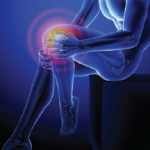Thirty years ago, knee osteoarthritis (OA), like gray hair and bags under the eyes, was thought to be an inevitable and largely untreatable consequence of getting old. But in the decades since, medical science has refuted the idea of OA as simply a “wear-and-tear” disease. New research shows that metabolic changes in the cartilage that are hallmarks of knee OA often occur after knee injury in young and middle-aged adults, too—and are often undetected for years.
Although OA is more prevalent with increasing age (11–15% of American adults 65 and older have OA in one or both knees), it’s found in a significant portion of middle-aged patients, too. “By their 30s and 40s, about 5% of the population has radiographic signs of OA, and we know disease might start 10 years prior to that,” explains Ewa Roos, PT, PhD, professor in the Institute of Sports Science and Clinical Biomechanics of the University of Southern Denmark. She spoke in a session at the ACR/ARHP Annual Scientific Meeting in November 2007.
There are a couple of obvious differences between the two populations of knee OA patients, Dr. Roos adds. For one, most elderly OA patients are women; in the younger groups, most OA patients are men. “And there are always differences in bone structure, cartilage, and muscles when you’re 35 and when you’re 75,” she says.
“Osteoarthritis is now listed on the World Health Organization’s top 10 list of global disease burden, with the knee being one of the most frequently affected joints,” says clinical epidemiologist Martin Englund, MD, PhD, a research associate at the Boston University School of Medicine and another speaker at the session. In the future, as the growing numbers of middle-aged people with undetected OA get older, the disease is only going to become a bigger public health problem.
Drs. Englund and Roos discussed how to diagnose and prevent OA in these younger age groups at a session called “Young Patients With Old Knees.”
Knee Pain in OA
The biggest problem in diagnosing OA in middle-aged patients is that those with OA symptoms—like pain, swelling, or stiffness—don’t always show signs of the disease on X-rays or even MRIs. The reverse is also true: Those with radiological evidence of the disease—such as joint narrowing due to cartilage loss and osteophytes—are not always symptomatic. Even more frustrating, “progression from high-risk groups into either of these categories is not well understood,” says Dr. Englund.


